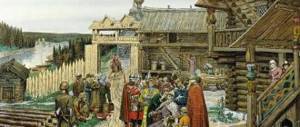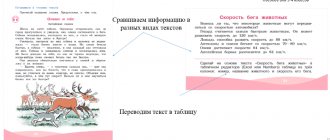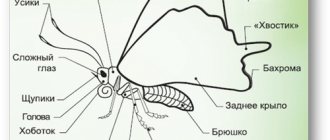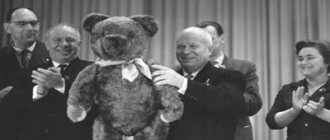Quote from Kapochka_Kapa's message
Read in full In your quotation book or community!
Russian heroes: who are they?
- prototypes, cartoons and audio tales What do we (and our children) know about Russian heroes?
Scraps from literature and cartoons...))
Russian heroes - Cartoons
Three heroes on distant shores 2012 online
Three heroes is a collective name for heroes from Russian epics.
The heroes' names were Ilya Muromets, Dobrynya Nikitich and Alyosha Popovich.
Each hero had one wife and a horse... xD
In general, the wives' names were Alyonushka, Nastasya Filippovna and Lyubava.
Well, the horses had names - Yuliy, Burushka and Vasya.
Well, what really happened?!!
Slavic history is rich in events, knowledge about which is passed on from generation to generation not only orally, but also in writing. Oral traditions are, as a rule, epics, including songs, tales, that is, everything that was composed directly by the people.
The basis of ancient Russian legends is, as a rule, heroes.
If we talk about the etymology of the word “hero” itself, then it is interpreted as a demigod man, or a person endowed with the power of a god. The origins of this word have been the subject of intense debate for a long time. Versions have been put forward about its borrowing from Turkic languages, and even from Sanskrit.
It is now generally accepted that the word “hero” was borrowed from the Tatar language.
Russian scientists distinguish two main categories of heroes - senior and junior.
It is customary to rank among the senior heroes
Svyatogor, Mikul Selyaninovich, Volga Svyatoslavich, Suhan.
This group, according to scientists, is the personification of various natural phenomena, in most cases - menacing phenomena hostile to the common man.
The group of younger heroes includes
the famous “Vasnetsov” trinity Ilya Muromets, Dobrynya Nikitich and Alyosha Popovich. They are also the personification of natural phenomena, but only those beneficial to humans.
Russian heroes audiobooks – 32 EPICS
One of the most mysterious characters of the Slavic epic is Svyatogor.
How did you know about them?
The first mentions of Russian heroes were recorded by scientists of the 19th century, Hilferding and Rybnikov. Before that, stories were passed down by word of mouth, from fathers to children. Naturally, in order to attract attention, adults had to constantly embellish and supplement the epics with new elements. Nowadays, it is generally accepted that there are two categories of heroes, namely junior and senior.
Elders were those heroes who appeared before the beginning of the Christian era. In some stories they are presented as fairy-tale creatures that have incredible or even magical powers. Modern historians identify them as Slavic idols that were formerly worshiped.
The heroes, who are considered to be the youngest, have a human appearance. They do not have transcendental power; they are not subject to any element. What is characteristic of them is that many of them lived during the reign of Prince Vladimir. Many chronicles of past years indicated that some events actually took place in history. Russian heroes really protected Rus' and for a long time were considered protectors of the people.
People shared unsuccessful purchases made online (photo)
Mikhail Efremov will be cut out of episodes in the series about vampires, but will be left in some places
Wow, how time flies: a Ural resident combined old and new photos of Yekaterinburg
Here are some heroes who most often appeared in various tales and epics.
- This is Ilya Muromets.
Reconstruction of the appearance of St. Ilya Muromets
This hero had those traits that were mainly attributed to mythical and fantastic heroes - the miraculous acquisition of great strength.
He was the son of simple peasant parents and was bedridden since childhood. This happens until the Kaliki wanderers appear. They order the boy to bring them water, and Ilya is healed. Moreover, he gains extraordinary strength. From that very moment, the heroic life of Ilya Muromets began, and his exploits became the basis for many epics and legends.
However, the most famous epic is his battle with the Nightingale the Robber.
By the way, until now scientists have not been able to come to a consensus about who Nightingale really was - either a fictional hero, or one of the warriors of the Mongol-Tatar army, or a simple robber living in Murom and ruined the merchants forced to pass through the Murom forests. At a certain period of time, Ilya comes to serve in Kyiv to save Rus' from numerous misfortunes and perform incredible and even miraculous feats.
***
The prototype of our main knight is Saint Elijah of the Pechersk, whose relics rest in the nearby caves of the Kiev Pechersk Lavra.
Ilya Muromets had a nickname; he was also called “Chobotok”. Chobotok is a boot. How Ilya Muromets received this nickname can be read in the surviving document of the Kiev-Pechersk Monastery:
“There is also one giant or hero, called Chobotka, they say that he was once attacked by many enemies while he was putting on a boot, and since in his haste he could not grab any other weapon, he began to defend himself with another boot, which had not yet been put it on and defeated everyone with it, which is why he received such a nickname.”
The fact that Ilya Pechersky is Ilya Muromets is confirmed by the book “Teraturgima” published in 1638. In it, the monk from the monastery Afanasy Kalnofoisky says that Saint Elijah, who is also called Chibitko, rests in the caves. The earthly life of the hero "Teraturgimus" dates back to the 12th century.
New evidence of the identity of the historical Elijah of Pechersk and Ilya of Muromets appeared in 1988, when the Interdepartmental Commission of the Ministry of Health of the Ukrainian SSR was sent to the Kyiv-Pechersk Lavra.
The height of Elijah of Pechersk during his lifetime was 177 cm, which was impressive for Ancient Rus'. The epic's indication of the immobility of St. Elijah, up to 30 years of age, corresponds to data on a long-term spinal disease.
According to scientists, the ascetic was a warrior, this was evidenced by calluses on the ribs that had healed after fractures. In addition, many other battle wounds were found on the body, one of which was apparently fatal.
According to this theory, Ilya Muromets lived in the 12th century and died in the Kiev Pechersk Lavra around 1188. Canonized in 1643 by the Orthodox Church as “Reverend Elijah Muromets.”
Memory according to the church calendar - December 19 (January 1)
The theory of the identity of the epic hero with the monk Chobitko from the Kiev Pechersk Lavra is quite plausible.
The relics rest in the Near Caves of the Kiev Pechersk Lavra. The tombstone of Ilya Muromets is located near Stolypin’s grave. Part of the relics of Elijah - the middle finger of his left hand - is located in one of the churches in the city of Murom, Vladimir region.
his tomb in the Pechersk Lavra The first mention of the relics of Ilya Muromets, who in Western Europe was called Ilya the Russian, was noted in a message dated 1594 in the “Travel Notes” of Erich Lasotta. Having visited ancient Kiev, the Roman envoy described two heroic graves - the first was in the chapel of the St. Sophia Cathedral , next to the chapel where Prince Svyatoslav the Wise and the holy Equal-to-the-Apostles Princess Olga were buried, and the second in the Anthony Cave of the Kiev Pechersk Lavra (where the holy relics were actually preserved). Describing the heroic grave in the St. Sophia Cathedral, Lasotta reports, “the tomb is now destroyed, but in the same aisle the tomb of his comrade was preserved” (apparently Dobrynya Nikitich, author). In the cave of the Kiev Pechersk Lavra, the Roman envoy saw the relics of another hero, nicknamed “Chobotok”. There is other evidence where the name “Chobotok” is called the popular nickname of Ilya Muromets. This is the description of the Kiev-Pechersk Monastery and its 64 miracles in the book of Afanasy Kalnofoysky, published in 1638. Afanasy calls the giant Chobotok Ilya Muromets and even reports the date of his death (approx. 1188). It turns out that there really was Ilya Muromets I, who lived under Vladimir I (the saint) and Ilya Muromets II who lived under Vladimir II (Monomakh). The tomb of the first Elijah was destroyed in 1240, during the capture of Kyiv by the Tatar-Mongols, but the second tomb, located in the Antonyev Cave, was preserved. The legendary image of Ilya Muromets turned out to be so attractive that Ilya is also known in German epic poems and Polish chronicles. Russian epics about him have been preserved and written down in the Russian north and in Cossack villages on the Don. Nowadays, local historians of various cities (according to the principle - each sandpiper praises its own swamp) attribute Ilya’s birthright to their land. Here are the most “rabid” of them - “Muromets is Murumets - “grass forest” translated from Estonian. In Tallinn they always knew that the famous Russian hero was actually an Estonian,” or that Ilya Muromets was from Moravia, where in the Middle Ages there was a Slavic principality (the state of Samo).
Alexey Rudevich
https://www.cossack.su/article/read/kazachestvo_ver...na_v_period_kievskoy_rusi.html
It is written here in great detail -
Bogatyr Mikula Selyaninovich. Mighty Ploughman
Mikula is mentioned in two epics. They write about him not as a mighty warrior, but as an incredibly resilient person. He does not fight, but plows the land. And this is surprising, because he is the only one of the heroes who personifies the image of a peasant plowman. In terms of physical qualities, he is compared with Svyatogor. Most likely, such an image was created due to the influence of various myths about creatures that have powers beyond our understanding. Mikula himself is not a representative of the earth element. Rather, thanks to his image they wanted to show the advantages of a settled life.
The action of a little girl was the best event of the day for a supermarket worker
Without a certificate of COVID-19 you will not be allowed into the sanatorium: take it no later than 3 days in advance
Joseph Gordon-Levitt on “The Third Planet from the Sun”: what the 90s series taught
N.V. Owl. About the historical prototype of Ilya Muromets
***
At the same time, another hero lived with Ilya Muromets,
whose name was Dobrynya Nikitich.
He was born in Ryazan, but like Muromets, he served in Kyiv.
The heroic story of Dobrynya begins from the moment when he defeated the Serpent Gorynych. The prince instructs him to engage in a fierce battle with the Serpent; on the way, the hero is overcome by little snakes, but Dobrynya manages to fulfill the prince’s order and free the girls and princes from the dragon caves.
In Kievan Rus, he carried out more important assignments, appearing before readers as a brave, wise warrior, who, among other things, is also the first assistant of Ilya Muromets.
The name “Dobrynya” means “heroic kindness.” The epic Dobrynya also has the nickname “young”, he is strong, and is the protector of “unfortunate wives, widows and orphans.” In addition, he is creative - he plays the harp and sings, and he is passionate - he does not avoid playing tavlei. Dobrynya is intelligent in his speeches and knows the subtleties of etiquette. It is clear that he is not a commoner. At the very least - a prince-commander.
***
The prototype of Dobrynya Nikitich is often called the chronicle Dobrynya, the maternal uncle of the real St. Vladimir.
The epic Dobrynya is compared by philologists (Khoroshev, Kireevsky) with the chronicle Dobrynya, the uncle of Prince Vladimir Svyatoslavovich.
Historically, Nikitich is not a middle name; the real Dobrynya’s middle name is quite Hollywood - Malkovich. And there were Malkovichs from the village of Nizkinichi. It is believed that “Nikitich” is precisely the “Nizkinich” transformed by the people.
The chronicle Dobrynya played a big role in the history of Rus'. According to the Tale of Bygone Years, it was he who advised the Novgorod ambassadors to invite Prince Vladimir to their place, and he also facilitated the marriage of his nephew to the Polovtsian Rogneda. For his deeds, Dobrynya, after the death of his brother Vladimir Yaropolk, became a Novgorod mayor and participated in the baptism of Novgorod.
If you believe the Joachim Chronicle, baptism was painful, “They baptized with the sword, and Dobrynya with fire,” the houses of the obstinate pagans had to be burned.
Excavations, by the way, confirm the great fire of Novgorod in 989. But there is another namesake, a hero of the 12th-13th centuries.
, described in the Abridged Chronicle of 1493: “In the summer of 6725 (1217). There was a battle between Prince Yuri Vsevolodovich and Prince Konstantin (Vsevolodovich) of Rostov on the river Gde, and God helped Prince Konstantin Vsevolodovich, the elder brother, and the truth came (defeated) him. And there were two brave (heroes) with him: Dobrynya the Golden Belt and Alexander Popovich, with his servant Torop.”
And further…
In the epics about Dobrynya Nikitich and Alyosha Popovich, heroes fight with Snakes. It should be said that the monsters of Russian epics differ from Western European dragons in that they always attack from above and never appear from the forest or from the water.
There is a version according to which the Snakes refer to the Polovtsian tribes that came to the Northern Black Sea region in 1055.
The name of the “Kai” tribe, which stood at the head of the Kipchak union (as the Polovtsians were called in Central Asia), translated into Russian means “snake”. The Polovtsian proverb “a snake has seven heads” (according to the number of main tribes) was widely known in the steppe; Arab and Chinese historians cite it in their works.
The chronicle after the victory over the Polovtsians in 1103 says that Vladimir Monomakh “twisted the heads of the serpents,” and the Polovtsian Khan Tugorkan, under the name Tugarin Zmeevich, entered the epics.
The name of another Polovtsian khan, Bonyak (a contemporary of Tugorkan), who terrified the population of Byzantium, Bulgaria, Hungary and Kievan Rus, was preserved in Western Ukrainian songs and legends in the plot about the head of Bunyaka Sheludivy, which, severed, rolls on the ground, destroying everything in its path.
The khan of the eastern association of the Polovtsians Sharukan in epics is called Kudrevanko the Tsar or Shark the Giant.
Later, the Tatar khans Batu and Kalin-Tsar (possibly Mengu-Kaan) appear in epics. One can, of course, point out that later the heroes were called Dobrynya in honor of the first prototype, but then it will be necessary to explain why the “feats” of a real boyar of the 10th century were not reflected in the epics.
***
Another famous hero, Alyosha Popovich, according to legend, was from the city of Rostov.
He ended up in Kyiv completely by accident. In an open field, the hero found a stone on which three roads were indicated: one led to Chernigov, the other to Murom, and the third to Kyiv. He also begins service at the court of Prince Vladimir. Perhaps the most famous story associated with Popovich is the tale of his fight with Tugarin (this, according to the epic, is a fictional character, which is why he sometimes bears the nickname Zmeevich and is presented as a monster). Tugarin is a foreign invader who can swallow an entire swan at a time, and is carried by servants on a golden stand. And Alyosha Popovich is always a young, brave and even sometimes reckless warrior.
There is always a connection between Ilya Muromets, Alyosha Popovich and Dobrynya Nikitich. There is also a great similarity between them not only in characters, but also in adventures and some life events.
Alyosha Popovich is the youngest of the trio of epic heroes. He looks the least warlike, his appearance is not menacing, rather bored. This is understandable - he is bored without fighting, without the adventures to which he was prone, since he defeated his enemies rather not by force, but by ingenuity and cunning. He is the most atypical of all the heroes, not very virtuous, boastful, greedy for the weaker sex.
***
Traditionally, Alyosha Popovich is correlated with the Rostov boyar Alexander Popovich , about whom there is more than one mention in the Nikon Chronicle.
He took part in the Battle of Lipetsk and died in 1223 in the Battle of the Kalka River.
However, just as you cannot remove words from a song, you cannot remove a feat from an epic. Alyosha Popovich became famous for two main feats - his victory over Tugarin the serpent and over the filthy Idolishch. The version of the comparison of the epic hero with Alexander Popovich does not explain any of these achievements, since victories over the filthy Idolishch and over Tugarnin the serpent were won two centuries before the Battle of Kalka.
Another version of who was the prototype of Alyosha Popovich was told by art critic Anatoly Markovich Chlenov. He believes that it is more correct to compare Alyosha Popovich with the boyar’s son and comrade-in-arms of Vladimir Monomakh, Olberg Ratiborovich.
According to the Tale of Bygone Years, it was he who killed the Polovtsian Khan Itlar, who came to negotiate in Pereyaslavl in 1095, by order of the prince, shooting him with a bow through a hole in the roof. Boris Rybakov, in particular, wrote that the name Idolishche, in all likelihood, is a distortion of Itlar through the form “Itlarishche the filthy.” It is characteristic that in the entire epic tradition it is the murder of the filthy Idol that is the only example of the murder of an enemy in the palace, and not in the “open field”.
The second feat of Alyosha Popovich is the victory over Tugarin the Serpent. Philologists found the prototype of the “snake” back in the 19th century; at the beginning of the 20th century, the version was voiced by Vsevolod Fedorovich Miller. “Tugarin the serpent” is the Polovtsian khan Tugorkan from the Shurakanid dynasty. Sharukan among the Polovtsians meant “snake”. So everything comes together. According to Boris Rybakov, the name Olberg over time was transformed into the Christian Olesha, and the comparison of Alyosha Popovich with the historical governor Alexander Popovich, according to Dmitry Likhachev, is later.
There is a lot here -








